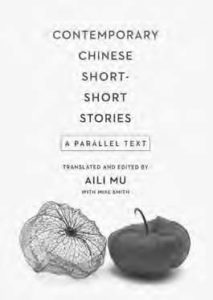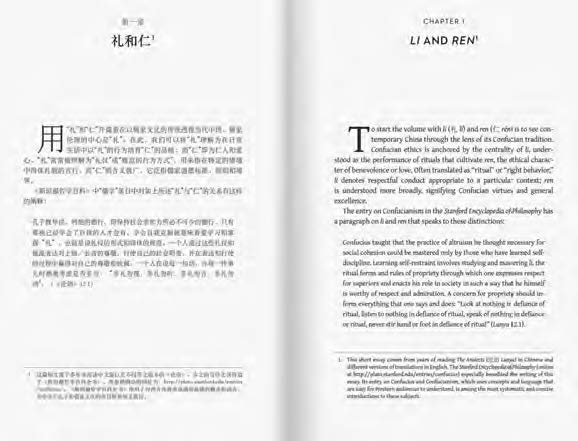Translated and edited by Aili Mu with Mike Smith
New York: Columbia University Press, 2017
528 pages, ISBN: 978-0231181532, Paperback
 Short-short story (xiao xiaoshuo or weixing xiaoshuo in Chinese, normally within the range of 800–1,000 words) has been a well-received literary genre among Chinese readers for decades. It revitalizes and interweaves several important threads in Chinese literary and cultural legacies: the classical genres of Tang chuanqi (romance), Song huaben (oral fiction), and Ming and Qing biji (notes) that encompass various short forms of writing such as tales, fables, sketches, anecdotes, folklores,
Short-short story (xiao xiaoshuo or weixing xiaoshuo in Chinese, normally within the range of 800–1,000 words) has been a well-received literary genre among Chinese readers for decades. It revitalizes and interweaves several important threads in Chinese literary and cultural legacies: the classical genres of Tang chuanqi (romance), Song huaben (oral fiction), and Ming and Qing biji (notes) that encompass various short forms of writing such as tales, fables, sketches, anecdotes, folklores,
social commentary, and miscellaneous thoughts; the time-honored storytelling tradition as an important constituent of folk culture catering to popular sentiments and tastes; and the May Fourth pursuit of modern literary realism in the baihua (vernacular) style. Therefore, this literary genre has multivalent literary and cultural significances while demonstrating the elegance and succinctness of the Chinese language. However, the literary merit of short-shorts has not been fully recognized yet in the orthodox history of modern Chinese literature, mainly because of their miniature size. As a result, they have also been seriously undertranslated and understudied in the English-speaking world. The recent publication of Contemporary Chinese Short-Short Stories: A Parallel Text remedies such a sorry situation and fills a lacuna in the field of modern Chinese literary studies.
The editor and translator of this volume, Dr. Aili Mu, in collaboration with Mike Smith, is a pioneering figure in introducing this delightful literary form to English readers. She has coedited and cotranslated (with Julie Chiu and Howard Goldblatt) an earlier collection, Loud Sparrows: Contemporary Chinese Short-Shorts (New York: Columbia University Press, 2006). In her tireless efforts to study this less trekked front of modern Chinese literature, Mu has spent years conducting field research in China, interviewing writers, attending cultural events promoting short-shorts, collecting, translating, and annotating representative works of the particular genre. Her hard work has congealed in this thick volume (528 pages) that has won the prestigious 2018 Association for Asian Studies (AAS) Franklin R. Buchanan book award for her great contribution not only to the field of literary studies, but also for her development of an outstanding pedagogical resource in Asian studies (grades K–16).

Contemporary Chinese Short-Short Stories: A Parallel Text includes thirty-one short-short stories in total, which are categorized under nine interlocking themes: li (ritual and propriety) and ren (humanity or benevolence), xiao (filial piety), yin-yang, governance, identity, face, (romantic) love, marriage, and yi (changes). While the first half of the themes alludes to the time-honored teachings and cardinal virtues of Confucianism, the second half resonates more with readers’ daily experiences and life concerns as modern beings living in today’s world. Each themed section opens with a short preface that explicates the meaning of the central concept in the Chinese context. Following the informative prefaced essay, three to four short-shorts are grouped together to illustrate different aspects of the central theme and its manifestation in common people’s everyday lives and aesthetic imaginations.
The short-short author’s biography at the end of each story not only helps students come up with a better understanding of the literary text, but also brings together a broad spectrum of different groups of writers. In comparison to many other anthologies of modern Chinese literature, the volume selects works of established senior writers, literary professionals working in state institutions of art and literature, and common folks from all walks of life whose names are less known to students and scholars of modern Chinese literature. The inclusion of the underrepresented group of writers sheds unusual light on common people’s aesthetic creativity, apprehensions and aspirations, and upward mobility in contemporary Chinese society.
In addition to the short introduction at the beginning of each themed section, what is equally helpful for readers of this book is a bilingual general introduction to the whole volume. The volume introduction, coauthored by Mu and Smith, identifies the central issue in the current Chinese-language teaching on American campuses: “how do we train a student who can greet a Chinese associate at the airport into someone who also understands Chinese culture well enough to develop and sustain collaborative relationships?” (xxi). Indeed, this is a question weighing on many Chinese teachers’ minds. This volume presents an experienced teacher and scholar’s unmatched effort in addressing this important question. The selected short-short stories not only demonstrate authentic samples of Chinese-language usage, but also provide a window into the fast-changing social and ethical landscape in today’s China, making this popular literary genre an appealing and accessible tool of integrating essential cultural elements and social issues with language learning for intermediate- to advanced-level students on American campuses. Hence, this volume offers great opportunities of cross-cultural exchange and communication for readers to immerse in easily and engage critically with a different linguistic and cultural environment. Mu also composed a Chinese-language user guide, “How to Use This Parallel Text to Teach Chinese Language and Culture,” included at the end of the book. It is another valuable resource of pedagogical use that generously shares sample questions, teaching methods, and classroom activities for teachers of Chinese language and literature.
Thanks to its rich content, artful translation, and innovative format, this volume can be creatively deployed as an invaluable teaching tool for a variety of courses. First and foremost, it can serve as an ideal textbook for upper-level Chinese-language instruction. Current textbooks widely used in such a class are either lacking an “in-depth systematic understanding of cultural behavior” (xxi) or often feature an outdated collection of essays and short stories composed by the May Fourth intellectuals a century ago, such as Hu Shi’s “Mother’s Words” (Muqin de jiaohui) and Lu Xun’s “A Small Incident” (Yi jian xiaoshi). These canonical works, of course, are culturally and historically meaningful readings. However, they fail to catch up with the latest changes of contemporary China or engage with a reconfiguring social reality from a grassroots perspective, and thus could hardly be appreciated by American students. The vocabulary in these pieces published at the very beginning of the baihua wen yundong (vernacular Chinese movement) also appears esoteric and impenetrable for today’s young readers.
In comparison, stories collected in this 2017 volume can offer more updated reading materials written in the standard modern Chinese language. The glossary following each short-short story highlights a set of new words, phrases, and idioms; their pinyin romanizations; English meanings; and common usage, which help students grasp the fundamental meaning of the story. The following list of questions in both Chinese and English propels students to delve into a more in-depth discussion and critical analysis of the cultural connotations of the story under the guidance of the class instructor. In addition to improving their linguistic proficiency in the target language, students can also develop their communication skills and cross-cultural awareness through reading and discussing a series of bilingual texts centered on various cultural values and sensibilities, institutional structures, practices of governance, and ways of life. If needed, these discussion questions can be easily converted into topics for writing assignments that extend students’ critical engagement with a different language and culture, and encourage them to make thoughtful reflections on their own cultural assumptions and stereotypes in the written form. Informed by Mu’s longtime rich experience in teaching advanced Chinese-language and translation classes, this volume showcases an innovative effort in developing “a curricular structure that integrates language and culture learning” (ix).
Another particularly well-designed feature in the layout of the anthology is its side-by-side parallel text format, i.e., on the left page, the Chinese text is printed, and on the right page, its English translation is juxtaposed. Such a layout allows students to refer to the English text easily when they encounter language barriers in the original Chinese text. This format renders a smoother and more enjoyable reading experience. It also creates a great opportunity for teachers to use this book in a translation class. Chinese University Press of Hong Kong and Penguin have published their own series of bilingual Chinese literary works, but they tend to focus on longer pieces. With a more concise form of short-short stories, students in a Chinese–English translation class will find it much easier to concentrate on a close reading, or what Mu calls an “analytical scrutiny” (xix) of a manageable size of the text, comparing its original Chinese version with its English translation. Following such a careful line-by-line examination and analysis, students, under the teacher’s guidance, can continue discussing a series of linguistic and cultural differences, and what possible translational strategies can be adopted to deal with the challenges caused by such differences. The inclusion of several excellent translational works of Mu’s students would encourage more students to follow their exemplary models and take up the daunting but rewarding task of literary translation.
Indeed, the parallel bilingual format of this volume makes it a truly versatile tool of education for different types of classes. In addition to Chinese- language and translation classes, this book can also be used in an introductory course on Chinese literature and culture for students with little or no knowledge of the Chinese language. In my contemporary Chinese literature class, I have used several short-short stories from this volume and other anthologies. Stories like “Catharsis” and “Fake Love Letter” help students gain a better understanding of common people’s lives during the Cultural Revolution (1966–1976), as well as the resilience of love, courage, and humanity even at the most turbulent and traumatizing historic moments. Short-shorts are often my students’ favorite works, thanks to their engaging plots, unique storytelling skills, stylistic innovation, nuanced interpretation of cultural values, and ingenious capacity of dealing with a variety of issues and themes within a shorter span of reading time and textual length.
In addition to literature classes, a wide array of survey courses, ranging from contemporary China to Chinese cultural legacies or East Asian civilizations, might find this volume a precious asset. For instance, when I deliver a lecture about changing family structure and ethics in contemporary Chinese society, the altering practices of filial piety often stir students’ interests and ignite a cross-cultural discussion in which students compare the Confucian idea of filial piety with the American pattern of old-age support and draw on their own personal observations. The section on xiao in Mu’s volume will serve as wonderful reading material for a teaching session like this. These short-shorts provide concrete case studies of the multiple meanings and forms of filial piety in a fast-changing Chinese society. The vivid depiction of the affectionate intergenerational bonding in Chi Zijian’s “Father Makes the Lantern” challenges a common assumption shared by many American students that xiao is forced on the younger generations by their elderly family members and thus carries the negative connotations of dominance and subjugation in an individualistic society. Through such a cross-cultural learning process, students become more aware of their own experiences and biases, and learn to make critical reflections on their own value assumptions and the American way of life lived and taken for granted on a daily basis.
To prepare the next generation for an increasingly globalizing and interconnected world, cultivating students’ critical thinking ability and openness to pluralistic voices and a global vision have become core constituents in American college curricula. In this light, this volume serves as a great educational tool that encourages students to nurture a more nuanced understanding of alternative value systems and ways of thinking, behaving, and living, which often challenges their possibly ethnocentric views of a different language, culture, people, and society on the other side of the globe. ■

